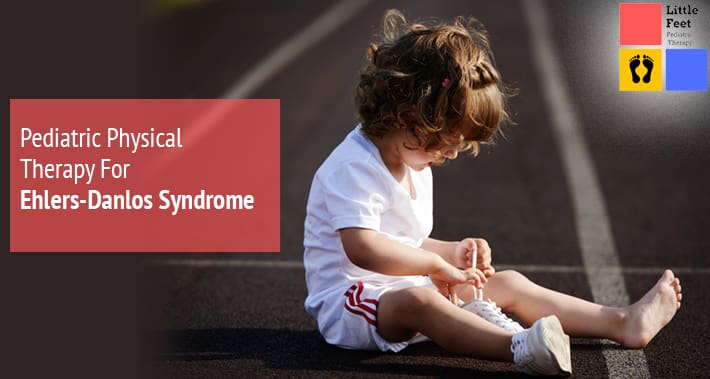
Ehlers-Danlos syndrome is a chronic condition affecting connective tissues in the body.
This can affect joints, skin quality and, in some cases, the organs.
Ehlers-Danlos syndrome can also cause developmental delays in children and affect their motor skills.
Although there is currently no known cure for Ehlers-Danlos Syndrome, a pediatric physical therapy clinic can help.
Your child’s physical therapist can provide a personalized treatment plan for your child to help alleviate some of their symptoms, such as pain and hypermobility.
If your child has received a diagnosis of Ehlers-Danlos syndrome, or you suspect they may have it, you may be worried.
But you’re not alone – at Little Feet Therapy, we’re here to help.
Today, we take a closer look at Ehlers-Danlos syndrome.
We’ll explore what it is, its symptoms, what causes it, and how pediatric therapy can help.
What Is Ehlers-Danlos Syndrome?
Connective tissue, like the name suggests, is the tissue that connects your various parts to each other.
It’s made up of tendons, ligaments, cartilage, bone, blood, skin, and more.
Ehlers-Danlos syndrome is a group of congenital disorders that cause connective tissue abnormalities.
There are thirteen different subtypes, but three in particular are the most common.
These are hypermobile, classic, and vascular Ehlers-Danlos syndrome.
Each has different symptoms, but they all have joint hypermobility in common.
Let’s take a look at each of them below.
Hypermobile Ehlers-Danlos Syndrome
Hypermobile Ehlers-Danlos syndrome is the most common type.
Previously, it was known as EDS III.
If you suspect your child has hypermobile Ehlers-Danlos syndrome, we’ll take a look at your family history and do a physical evaluation to see.
How To Tell If Your Child Has Hypermobile Ehlers-Danlos Syndrome
Symptoms of hypermobile Ehlers-Danlos syndrome include:
- Joints that easily dislocate
- Frequent headaches
- Dizziness, especially when they stand up
- Crowded teeth, bleeding gums, and frequent cavities
- Chronic pain that gets worse as they grow older
- Insomnia
- Mental health issues
- Slow healing wounds
- Frequent nosebleeds
- Digestive issues
Classic Ehlers-Danlos Syndrome
Classic Ehlers-Danlos syndrome is the second most common type of Ehlers-Danlos syndrome.
It’s identified through genetic testing.
Specifically, genetic testing looks for a change in one copy of either the COL5A1 or COL5A2 gene.
How To Tell If Your Child Has Classic Ehlers-Danlos Syndrome
The most telltale symptom of classic Ehlers-Danlos syndrome is stretchy skin.
If your child has classic Ehlers-Danlos syndrome, you’ll notice their skin is soft, stretchy, and can easily tear.
Other common symptoms include:
- Loose joints
- Chronic bruising and scarring, especially on the shins
- Slow healing wounds
- Scars that appear very thin
- Heart issues
Vascular Ehlers-Danlos Syndrome
Vascular Ehlers-Danlos syndrome is the rarest of the three we’re looking at today.
It also tends to be the most severe.
Diagnosis for this one is done through genetic testing as well
How To Tell If Your Child Has Vascular Ehlers-Danlos Syndrome
Common symptoms of Vascular Ehlers-Danlos Syndrome include:
- Skin so thin you can see blood vessels
- Chronic and extensive bruising
- Very loose small joints (fingers)
- Thin nose and lips
- Sunken cheeks
- High risk for organ ruptures
It’s worth noting that although smaller joints are very loose, the larger joints (knees, hips, shoulders, etc.) aren’t usually affected.
What Causes Ehlers-Danlos Syndrome?
Ehlers-Danlos syndrome is caused by a genetic mutation.
Researchers have identified a number of different genetic mutations that caused Ehlers-Danlos syndrome.
They’re all related to the production of collagen, a protein your body uses to create connective tissue.
We’re still in the early stages of understanding how these mutations work.
But we do know they can be inherited – if you or your partner has Ehlers-Danlos syndrome, for example, your kids are more likely to have it.
How Can Pediatric Physical Therapy For Ehlers-Danlos Syndrome Help?
Pediatric physical therapy is a key intervention for managing the symptoms caused by Ehlers-Danlos syndrome.
Currently, there is no known cure, but your child’s physical therapist can still help.
Treatment usually focuses on alleviating symptoms associated with Ehlers-Danlos syndrome.
1. Pain Management
Chronic pain is a common complaint among people with Ehlers-Danlos syndrome.
As a result, pain management is a big part of a pediatric physical therapy approach.
But it’s important to start at a low intensity.
After all, kids with Ehlers-Danlos syndrome tend to be easily injured.
Strengthening the muscles and stability around the joints can help reduce your child’s Ehlers-Danlos syndrome pain.
Soft tissue manipulation and other soft tissue therapy by a pediatric physical therapist can also help with pain management.
Other treatment options for pain management may include:
- Heat and cold therapy
- TENS (transcutaneous electrical nerve stimulation)
- Myofascial release
- Relaxation techniques
- Learning to pace themselves
- Fitting your child for braces, where necessary
2. Motor Skills Development Exercises
Kids with Ehlers-Danlos syndrome often have delayed motor skills development.
As a result, your child’s physical therapist will work with them to develop their motor skills in a way that minimizes pain and keeps them safe from injury.
This may include gross motor skills like walking or running safely.
It may also include fine motor skills like being able to fasten buttons or tie their shoes.
This can help your child work toward greater independence.

3. Muscle Development Exercises
When beginning treatment for Ehler-Danlos syndrome, your child may have some muscle weakness.
Your child’s physical therapist will develop a treatment plan that will allow your child to strengthen their muscles.
It’s important to use low impact exercises, since these minimize the risk of injury or pain.
and focus on upper and lower extremities and core strength.
Some examples of exercises that your child’s physical therapist may suggest include:
- Bridging
- Hip adduction isometric
- Wall squats
- Heel raises
4. Posture Control
For children with Ehlers-Danlos syndrome, improving posture and core stability will support the overload of pressure on their joints.
This can help manage their pain, as well as prevent further pain.
After all, gait abnormalities can contribute to uneven weight distribution.
That in itself may cause pain down the road.
Your child’s physical therapist will assess and suggest treatment to improve all aspects of your child’s posture.
5. Balance Exercises
The physical complications from Ehlers-Danlos syndrome can cause kids to struggle with their balance and proprioception.
The strength and posture exercises mentioned above will help with this.
As well, your child’s physical therapist will provide balance oriented exercises to help your child better support themselves.
6. Addressing Craniocervical Instability
Craniocervical instability is a potential complication for kids with Ehlers-Danlos syndrome.
In most kids, the ligaments from their skull to their spine will develop in a way that stops them from moving in unsafe ways.
If your child has craniocervical instability, that development doesn’t happen in the same way.
This can cause injuries to their nervous system, as well as structural instability in their spine.
Common symptoms include:
- Chronic headaches and neck pain
- Sleep apnea
- Balance issues
- Chronic fatigue and brain fog
- Pain or numbness in their face
- Tinnitus
- Swallowing issues
- Frequent dizziness
- And others
Kids with Down syndrome also frequently deal with craniocervical instability.
In severe cases, kids with craniocervical instability may need corrective surgery, but this is rare.
In most cases, pediatric physical therapy can help.
Treatment may include:
- Exercises to improve proprioception
- Exercises to improve posture
- Soft tissue and joint manipulation
- Spinal manipulation
- Muscle strengthening exercises
- And others
Depending on the severity, your child may also need to wear a neck brace.
7. Addressing Postural Orthostatic Tachycardia Syndrome(POTS)
POTS is another condition that commonly occurs in kids with Ehlers-Danlos syndrome.
It’s a condition where, after standing up from a seated or lying down position, your child’s heart rate starts beating faster than normal.
Symptoms vary from person to person, but may include:
- Dizziness or lightheadedness
- Fainting
- Difficulty focusing
- Tachycardia (rapid heart rate over 100 BPM)
- Nervousness or anxiety
- Chest pain
- Shortness of breath
- Body tremors
- Headache
- Nausea
- Discolored face, hands, or feet
- Exhaustion
- and others
These symptoms may happen immediately after standing up, or they may develop after a few minutes.
They also tend to be worse after being in warm environments, after exercise, when your child is otherwise ill, or after standing for a long time.
Your child’s physical therapist can help manage these symptoms.
This involves a program to gradually build your child’s strength and endurance.
The goal is to retrain your child’s body to reduce these symptoms.
Compression stockings may also help.
Book Your Appointment With Little Feet Pediatric Therapy Today
Pediatric physical therapy can help alleviate the common symptoms of Ehlers-Danlos syndrome in your child.
Following a consistent plan provided by a pediatric physical therapist will translate to positive improvements in pain and everyday activities.
This can improve your child’s quality of life.
If you suspect your child has Ehlers-Danlos syndrome, it’s a good idea to get them evaluated as soon as possible.
Here at Little Feet Pediatric Therapy, we’re here to help.
Book your appointment with Little Feet Pediatric Therapy today.
► 3535 Randolph Rd, Charlotte, NC 28211
► 1331 H St NW Ste 200, Washington, DC 20005
► St. Louis, MO
► Raleigh, NC
Founded in 2019, Little Feet Therapy offers on site pediatric physical and occupational therapy treatments for children from 2 months to 18 years old with physical and developmental concerns. Our clinics focus on providing therapy in a child’s natural setting where your child is in familiar surroundings, it puts their mind at ease and helps them focus more on the work they’re doing with their pediatric therapist. Our therapists will work with your child at your home, at school, at daycare, or another place in the community where they feel most comfortable.